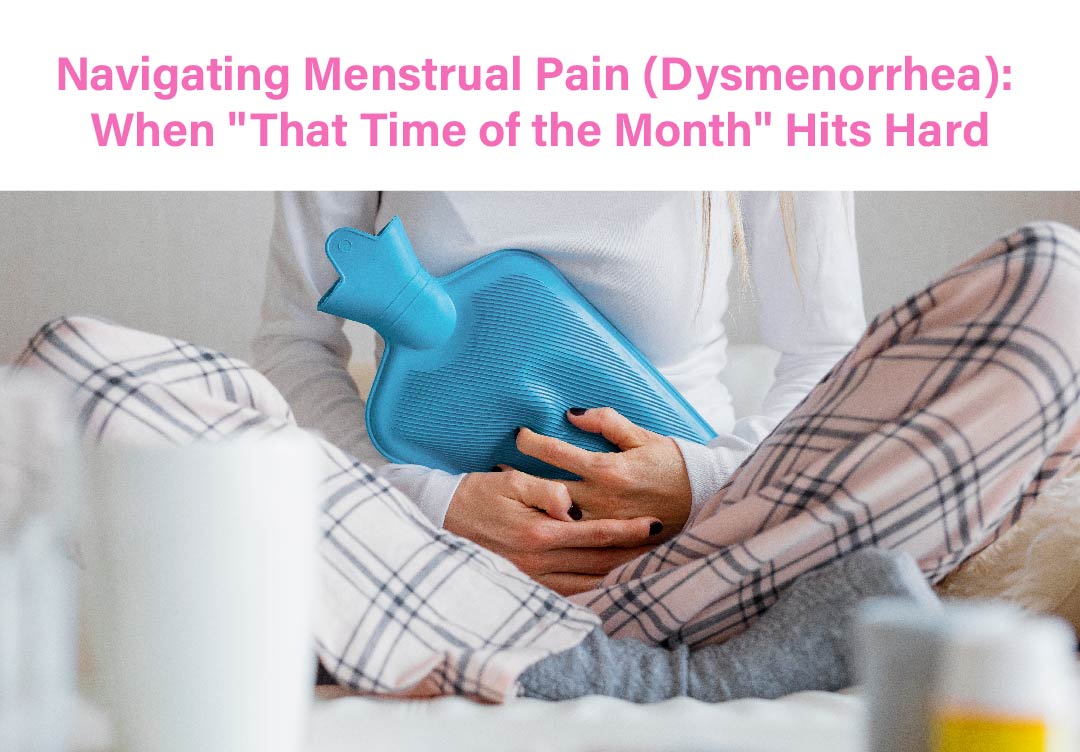
Dealing with that monthly visitor, “your period” can be a real pain. Literally! You're not alone if you've experienced discomfort during your menstrual cycle, every other woman suffers from period pain. For some, it could be a mere annoyance, and for some, it could be intense enough to impact day-to-day activities. If you are one of the many individuals suffering from painful periods, you're likely familiar with a range of discomforting symptoms. These may include intense throbbing pain in your lower abdomen, typically surfacing 1 to 3 days before your period and reaching its peak during your menstrual cycle. For some of us, the pain can be so intense that it extends to the lower back and thighs, and causes other symptoms such as diarrhea, nausea, vomiting, headache, and dizziness.1,2

Dysmenorrhea is the medical term for painful menstrual cramps due to uterine muscle contractions for shedding the lining of the uterus.3
Dysmenorrhea is the most common problem in females of reproductive age.3 The prevalence of dysmenorrhea ranges from 16%-91%.3 Period pain is the leading cause of absenteeism, it also manifests as presenteeism, where despite being physically present the individual struggles to perform at her full capacity.4,5
Now, let's understand the two main types of this condition:

Primary dysmenorrhea is the more common type of dysmenorrhea which is not associated with other diseases of the uterus. It is caused due to the release of natural chemicals called prostaglandins, which cause the womb to contract leading to pain. The levels of these chemicals are usually high during the beginning of the period and they go down as the period ends explaining why pain usually lessens after the first few days of the period.1,6,7

Secondary dysmenorrhea is menstrual-related pain due to an underlying disease of the uterus. This type of pain gets worse and continues throughout the period and may also continue after the period ends.1,6,7
Common causes of secondary dysmenorrhea are: 1,6,7
• Uterine fibroids
• Pelvic inflammatory disease
• Endometrial polyps (A condition that causes overgrowth of uterine lining)
• Endometriosis (A condition in which tissue that is similar to the inner lining of the uterus grows outside the uterus)

References:
1. Dysmenorrhea. Cleaveland Clinic [Internet]. Available at: Dysmenorrhea: Menstrual Cramps, Causes & Treatments (clevelandclinic.org). Accessed on: Oct 18, 2023.
2. Menstrual cramps. Mayoclinic [Internet]. Available at: Menstrual cramps - Symptoms & causes - Mayo Clinic. Accessed on: Oct 18, 2023.
3. Nagy H, Khan MAB. Dysmenorrhea. [Updated 2022 Jul 18]. In: StatPearls [Internet]. Treasure Island (FL): StatPearls Publishing; 2023 Jan-. Available from: https://www.ncbi.nlm.nih.gov/books/NBK560834/
4. Cook A, Hoek D V R. Period pain presenteeism: investigating associations of working while experiencing dysmenorrhea. Journal of psychosomatic obstetrics & gynecology. 2023 Mar 8; 44(1).
5. Dysmenorrhea. American Family Physician [Internet]. Available at: https://www.aafp.org/pubs/afp/issues/2021/0800/p164.html. Accessed on: Nov 15, 2023.
6. Dysmenorrhea: Painful periods. The American College of Obstetricians and Gynecologists [Internet]. Available at: Dysmenorrhea: Painful Periods | ACOG. Accessed on: Oct 18, 2023.
7. Dysmenorrhea. MSD Manual [Internet]. Available at: Dysmenorrhea - Gynecology and Obstetrics - MSD Manual Professional Edition (msdmanuals.com). Accessed on: Oct 18, 2023.


